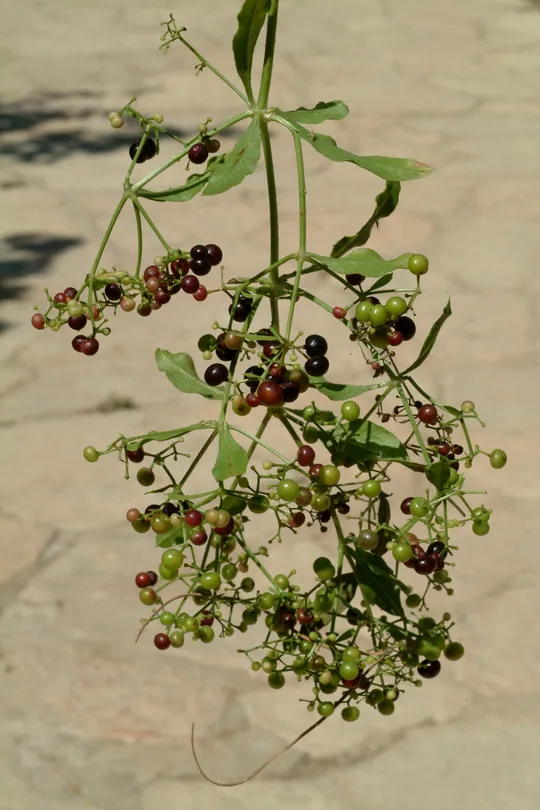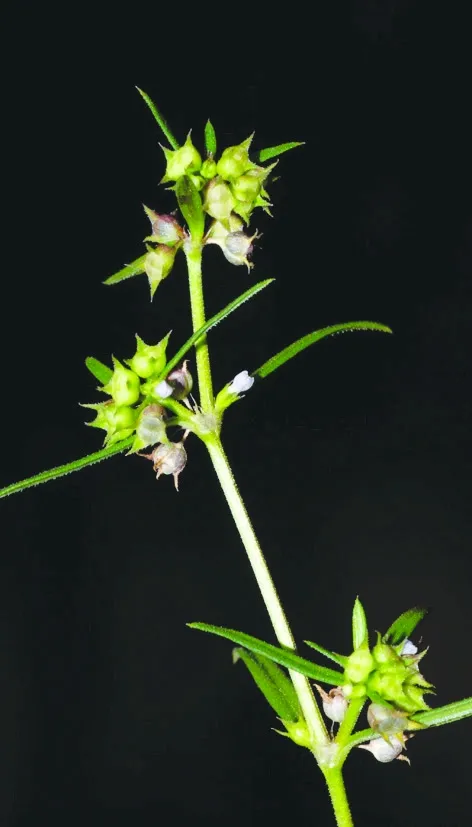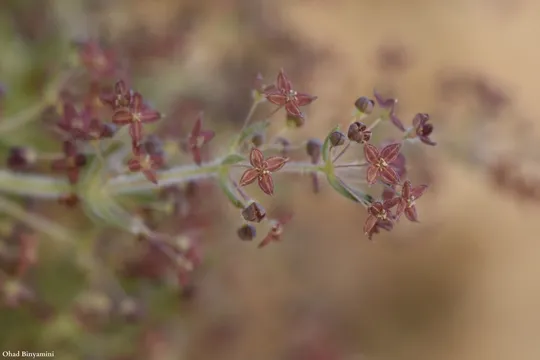Common Madder, Dyer's Madder
Rubia tinctorum

Rubia tinctorum is an important
source of red dye that has been produced from its roots since ancient times,
which is how it got its name. During the Mishnaic Period it was known as one of
the most important plants, with which fabrics and clothing were dyed. Essene
bones discovered in caves at Qumran were dyed in red. Apparently, the Essenes
ate the roots of R. tinctorum,
which grew in the area in order to strengthen their bones. Chemical tests of
the plant discovered that it contains 40% calcium, and that 2 grams of R. tinctorum roots can provide the body with its required daily calcium intake.
Plant dyes were particularly suited for dyeing fabrics, particularly
those made of wool, as linen can only be dyed blue. Talmudic sources mention
many dyes produced from plants, but in the dyed woven fabrics discovered during
previous archeological digs in the Arava, the Judean Desert and the Samarian transition
zone only three major plants that contributed to the color diversity were
found: Indigofera tinctoria, Isatis tinctoria and Rubia tinctorum. The main color
in these woven fabrics – red – was probably produced from the root of R. tinctorum,
a process that was restored by Yehudit Safrai (Shamir and Baginski, Ayalon,
1993).
Rubia tinctorum
was collected only twice in the Kinarot valley (upper Jordan Valley), at two
sites in Gaon
HaYarden: east of Tirat
Tsvi (Uri Eliav, 1956; it was also observed there in the 1990s by Mimi Ron in
2009) and east of Kfar Rupin (1988). The estimated number of sites is three. It
is not known whether the plant grows on the Jordanian side of Gaon
HaYarden. During the 1980s
and 1990s, feral specimens were observed in the Judean Mountains, in Givat Ram
in Jerusalem and in Moshav Mata.
It is not clear, what the primary habitat of the plant
was. In Israel, the natural habitat of Rubia tinctorum is moist banks of flowing streams. Outside Israel, the plant is characteristic
of woodland and forest edges or along hedges of shrubs and trees in steppe
areas and internal valleys. R. tinctorum also grows as a cultured
plant that is used as a source of dye.
The genus Rubia includes 60 species that are
commonly found in Europe, the Mediterranean Basin, Asia and America. The genus
center is in fact concentrated in the sub-tropical region. Is close to the genus
Galium,
but unlike it has five petals compared with four petals in Galium. As
far as other details are concerned, they have a similar flower structure. In Israel,
there are two species of Rubia. The more common one is R. tenuifolia
that grows throughout the Mediterranean region. Unlike R. tinctorum,
it has woody stalks bearing dark green and very coarse leaves.
Rubia tinctorum grows naturally
in Israel in a single region at two sites. The number of plants is small. The
instability of the water regime in Gaon
HaYarden and the small size of the R. tinctorum populations threaten the continued existence
of the species in the wild in Israel. One site is protected within Gaon
HaYarden Reserve. It is not
globally endangered, partly by the fact that it grows well in culture. It has been given the
status of “Vulnerable" (VU) in Switzerland.
A thorough survey
should be conducted along the banks of the Yarmouk and the Jordan Rivers from
El Hamma to Jericho to identify Rubia tinctorum populations and formulate
a monitoring and conservation program.
Rubia tinctorum has a mainly Irano-Turanian
distribution: it probably grows naturally in the Middle East and Central Asia
up to the northwestern Himalayas. The species is cultivated in large areas of
southern Europe for the red dye obtained from its roots.
Rubia tinctorum grows in
Israel as an extremely rare wild plant, found only in Gaon HaYarden
in the Bet She’an Valley. It is an important cultured plant, which was once an
important source of red dye for woven fabrics. Gaon HaYarden and the Yarmouk estuary are a
unique natural site for R.
tinctorum, whose
preservation is highly recommended.
שמיר, א. וע. בגינסקי: אריגים קדומים בארץ-ישראל. מתוך: חדשות ארכיאולוגיות באינטרנט, אתר רשות העתיקות.
איילון, א.1993. "גנדרנות יקרה"- צבעים טבעיים בימי קדם. טבע וארץ, 261: 20-27.
Current Occupancy Map
| 1000 squre meter pixel | 5000 squre meter pixel | 10000 squre meter pixel | |
|---|---|---|---|
| number of observations | 0 | 0 | 0 |
| in total pixels | 0 | 0 | 0 |
| Family | Rubiaceae |
| Classification | On the endangered species list |
| Ecosystem | Mediterranean (humid?) |
| Chorotype | Mediterranean – Irano-Turanian (Euro-Siberian) |
| Conservation Site | Gaon HaYarden East of Tirat Tsvi |
| Rarity |
1
4
6
|
|---|---|
| Vulnerability |
0
3
4
|
| Attractiveness |
0
1
4
|
| Endemism |
0
0
4
|
| Red number |
1
4.7
10
|
| Peripherality | N |
| IUCN category | DD EW EX LC CR EN VU NT |
| Threat Definition according to the red book | Endangered |
 Based on:
Based on:






